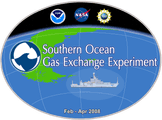- 1
- Campaigns
- 0
- Data Products

Overview
This description will be added in a future version.
Online information
Related Campaigns & Instruments
Review the instruments operated on this platform for each of these field campaigns
Slide 1 of 1

Southern Ocean Gas Exchange Experiment
2008
Southern Ocean
view all deployment dates
1 Deployment
· 0 Data Products| 2008-02-29 | 2008-04-12 |
The Riegl Laser Distance Meter is a ground-based lidar system manufactured by Riegl Laser Measurement Systems. It is a multi-purpose lidar system based on precise time-of-flight laser range measurements. It is used for accurate distance measurements for multi-target situations, such as measuring wave height. The Riegl Laser Distance Meter operates in the near-infrared (~0.9 μm) and has a measurement range up to 1300 meters, depending on the operating mode. It has a measurement rate of up to 2000 Hz and can detect a maximum number of targets of about 3 to 4.
Earth Science > Spectral/engineering > Lidar > Lidar Backscatter
Earth Science > Spectral/engineering > Lidar
LI-COR Gas Analyzer is an in situ gas analyzer manufactured by LI-COR. They can be deployed on aircraft, research vessels, vehicles, balloons, and ground-based platforms. They provide measurements of various trace gases such as carbon dioxide (CO2), methane (CH4), nitrous oxide (N2O), and water vapor (H2O). Most models use Optical Feedback-Cavity Enhanced Absorption Spectroscopy (OF-CEAS) to collect measurements. LI-COR gas analyzers have a typical measurement rate of 1 Hz and an operating temperature range of -25 to 45 degrees Celsius.
Earth Science > Atmosphere > Atmospheric Chemistry > Nitrogen Compounds > Ammonia
Earth Science > Atmosphere > Atmospheric Chemistry > Trace Gases/trace Species
Earth Science > Atmosphere > Atmospheric Chemistry > Carbon And Hydrocarbon Compounds > Methane
Earth Science > Atmosphere > Atmospheric Chemistry > Carbon And Hydrocarbon Compounds > Carbon Dioxide
Earth Science > Atmosphere > Atmospheric Chemistry
Earth Science > Atmosphere > Atmospheric Water Vapor
Earth Science > Atmosphere > Atmospheric Water Vapor > Water Vapor Indicators > Water Vapor
Earth Science > Atmosphere > Atmospheric Chemistry > Nitrogen Compounds > Nitrous Oxide
Generic-Atmospheric State (Gen-AtmsState) refers to non-specific instruments on a platform used for measurements of atmospheric state parameters. These are typically in situ sensors that measure temperature, pressure, humidity, and wind speed/direction. Types of atmospheric state instruments include thermometers, hygrometers, barometers, and anemometers.
Earth Science > Atmosphere > Atmospheric Water Vapor
Earth Science > Atmosphere > Atmospheric Pressure
Earth Science > Atmosphere > Atmospheric Water Vapor > Water Vapor Indicators > Humidity
Earth Science > Atmosphere > Atmospheric Temperature > Surface Temperature > Air Temperature
Earth Science > Atmosphere > Atmospheric Winds > Upper Level Winds > Wind Direction
Earth Science > Atmosphere > Atmospheric Winds > Upper Level Winds > Wind Speed
Earth Science > Atmosphere > Atmospheric Pressure > Atmospheric Pressure Measurements
Earth Science > Atmosphere > Atmospheric Winds > Surface Winds > Wind Direction
Earth Science > Atmosphere > Atmospheric Temperature
Earth Science > Atmosphere > Atmospheric Winds > Surface Winds > Wind Speed
Earth Science > Atmosphere > Atmospheric Winds
Conductivity, Temperature, and Depth (CTD) sensors are in situ instruments used to measure water depth, pressure, salinity, temperature, and density in the ocean. CTD sensors can be deployed on various water-based platforms such as autonomous underwater vehicles (AUVs), buoys, gliders, or research vessels. When mounted on a vessel, CTD sensors are usually attached to a rosette and then lowered to the seafloor to record water properties. These sensors typically sample at 30 Hz and can provide accurate measurements at specific water depths according to the researcher's needs.
Earth Science > Oceans > Ocean Pressure > Water Pressure
Earth Science > Oceans > Bathymetry/seafloor Topography > Water Depth
Earth Science > Oceans > Salinity/density > Conductivity
Earth Science > Oceans > Salinity/density > Density
Earth Science > Oceans > Salinity/density > Salinity
Earth Science > Oceans > Ocean Temperature > Water Temperature
Earth Science > Oceans > Salinity/density
Generic-Chemistry Related Sensors (Gen-Chemistry) refers to non-specific instruments on a platform used for atmospheric chemistry measurements. These are typically in situ analyzers that measure various chemical compounds such as trace gases, halocarbons, volatile organic compounds, nitrates, aerosols, and other chemical species. Measurements can include mixing ratio, composition, particle size, optical properties, and particle size distribution.
Earth Science > Atmosphere > Atmospheric Chemistry > Trace Gases/trace Species
Earth Science > Atmosphere > Atmospheric Chemistry
Earth Science > Atmosphere > Air Quality > Volatile Organic Compounds
Earth Science > Atmosphere > Aerosols
Earth Science > Atmosphere > Aerosols > Aerosol Particle Properties
Earth Science > Atmosphere > Atmospheric Chemistry > Halocarbons And Halogens
Earth Science > Atmosphere > Air Quality
Earth Science > Atmosphere > Atmospheric Chemistry > Carbon And Hydrocarbon Compounds
Accelerometers are in situ sensors that measure the acceleration experienced by an object. Accelerometers utilize electromagnetic sensing to detect the vibration of an object. The force of vibration causes the sensor to produce an electrical charge, indicating how much force was exerted, which can be used to determine the acceleration. Accelerometers are typically used on aircraft when collecting flight navigation information. Accelerometers have also been deployed on research vessels and other water-based platforms such as buoys.
Earth Science > >